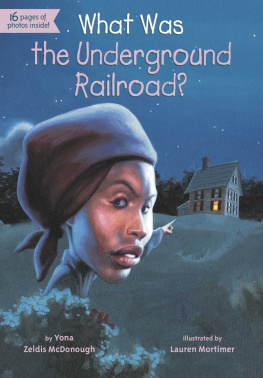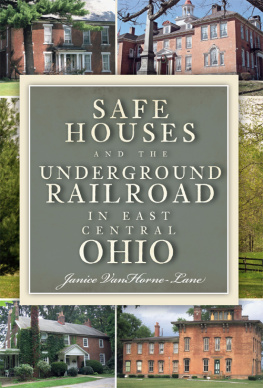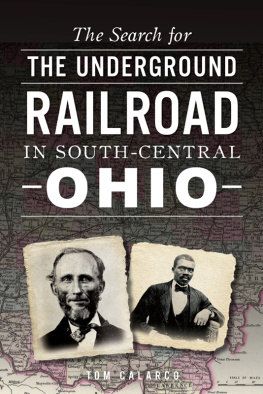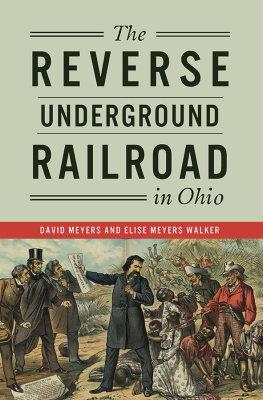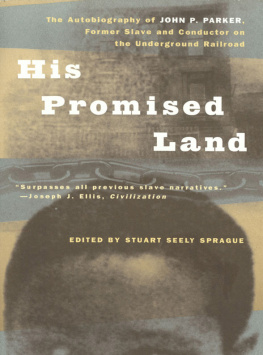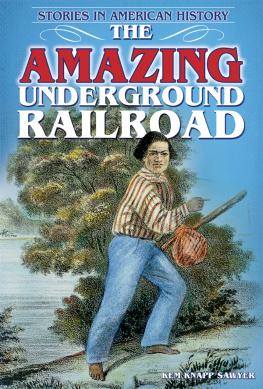Contents
Allen Jay
and the
UNDERGROUND
RAILROAD
by Marlene Targ Brill
illustrated by Janice Lee Porter
Millbrook Press / Minneapolis
For Alison and her grandmother, Genevieve, two people who enjoy action
packed stories and a little historyMTB
To JaiJLP
Note to readers: Many members of the Society of Friends during
the 1880s said thee for you in most all situations, rather than
using both thee and thou.
Special thanks to the many generous people who helped gather and verify
information for this book, especially Sabron R. Newton, librarian for the 57th
Street Friends Meeting, Chicago; Thomas Hamm, archivist at Erlham University;
Kamau Sababu Kambui, a historian and naturalist who specializes in the history of
the Underground Railroad; Gerald Canter, professor emeritus at the Department of
Communications Sciences and Disorders, Northwestern University; the staff of the
Wilmette Public Library (Illinois); and Marybeth Lorbiecki, editor.
Text copyright 1993 by Marlene Targ Brill
Illustrations copyright 1993 by Lerner Publishing Group, Inc.
All rights reserved. International copyright secured. No part of this book may be reproduced,
stored in a retrieval system, or transmitted in any form or by any meanselectronic, mechanical,
photocopying, recording, or otherwisewithout the prior written permission of Lerner Publishing
Group, Inc., except for the inclusion of brief quotations in an acknowledged review.
This book is available in two editions: Library binding by Millbrook Press, a division of Lerner Publishing Group, Inc.
Soft cover by First Avenue Editions, an imprint of Lerner Publishing Group, Inc.
241 First Avenue North
Minneapolis, MN 55401 U.S.A.
Website address: www.lernerbooks.com
Library of Congress Cataloging-in-Publication Data
Brill, Marlene Targ.
Allen Jay and the Underground Railroad / by Marlene Targ Brill ; illustrated by Janice
Lee Porter.
p. cm.
Summary: Recounts how Allen Jay, a young Quaker boy living in Ohio during the 1840s,
helped a fleeing slave escape his master and make it to freedom through the Underground Railroad.
ISBN-13: 9780876147764 (lib. bdg. : alk. paper)
ISBN-10: 0876147767 (lib. bdg. : alk. paper)
ISBN-13: 9780876146057 (pbk. : alk. paper)
ISBN-10: 0876146051 (pbk. : alk. paper)
1. Underground Railroad Juvenile literature. 2. Fugitive slaves United States
Juvenile literature. 3. Jay, Allen Juvenile literature. 4. Slavery and the church Society
of Friends Juvenile literature. 5. Quakers United States History 19th century
Juvenile literature. [1. Underground railroad. 2. Fugitive slaves. 3. Jay, Allen. 4. Quakers.]
I. Porter, Janice Lee, ill. II. Title.
E450.T17 1993
973.7'115 dc20 92-25279
Manufactured in the United States of America
15 PC 12/1/10
eISBN: 978-0-7613-5838-1

Authors Note
Allen Jay and his family lived in Randolph, Ohio, during the 1840s. The Jays belonged to a religious group called the Society of Friends, or Quakers. Friends believed everyone was equal. So they dressed alike in plain clothes and called everybody thee, whether stranger or friend.
Sadly, most African Americans who lived in the Southern United States were not treated as equals. They were slaves. Slaves worked all day without
pay. Their bosses claimed to own them like animals. Any slaves who escaped were hunted and punished. They were often tortured or killed. People who helped slaves escape were punished too.
Allens parents, Isaac and Rhoda Jay, helped slaves run away even though it was dangerous. The Jays were part of a secret group called the Underground Railroad.
People who worked with the Underground Railroad hid runaway slaves in their barns, attics, and hidden rooms. They guided the runaways from one safe place to the next. Runaways traveled by foot, wagon, or horseback, following secret routes to Canada. There, everyone was treated equally un
der the law.
The Jays were careful not to tell others what they did not even their children. Eleven- year- old Allen knew that his parents fed and hid dark strangers who appeared and disappeared mysteriously. But he didnt understand much about slavery until the day he came face- to -face with a runaway.
July 1, 1842
A llen hung
the last shirt on the line.
His mother was too sick
to do such heavy work.
So the job fell to her eldest child.
Every Monday Allen washed, boiled,
starched, and hung out the clothes.
Afterward he was free to play.
This afternoon
Allen headed for the barn
to get his fishing pole.
As he crossed the front yard,
he saw a horse racing down the road
toward the Jay farm.
Within seconds
the family doctor stopped
at the front gate.
Friend Jay! Friend Jay!
the doctor shouted.
Allens father came out of the barn
and walked quickly to the gate.
Thy horse has wings today,
said Isaac Jay.
Thee seems in a hurry.
The doctor leaned toward Isaac.
A runaway slave is hiding
in the woods, the doctor said
in a low voice.
The slaves owner and his men
are following close behind,
and they have guns, he warned.
The doctor grabbed Isaacs shoulder
and added, Be careful, my friend.
Allens father nodded.
The doctor turned his horse
and rode away.
Allen moved closer to his father
and looked up into his troubled face.
Allen wondered,
Would the slaves owner come
and shoot his father?
He remembered stories
about other Friends
who helped runaways.
Some Friends had been beaten.
Others had had their homes burned.
Isaac Jay looked down at his son.
Allen, his father said,
thee may soon see





